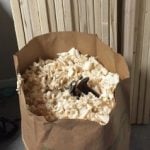Planing question…
Welcome! / Forums / General Woodworking Discussions / Woodworking Methods and Techniques / Planing question…
- This topic has 6 replies, 6 voices, and was last updated 6 years, 7 months ago by
 Misha.
Misha.
-
AuthorPosts
-

I’m trying to determine if this issue is caused by the hardness of the wood, the angle of the plane iron grind or possibly something else…
I have found that sometimes/often when I am trying to plane a very hard piece of wood (hard maple for example), that I end up exerting a lot of energy because it doesn’t seem that my plane iron is biting the wood at all–rather it seems to skip over the surface and take off no shavings (which results in me getting frustrated and extending more iron/exerting more down force, which doesn’t seem to change the results at all). Currently I’m having a bit of an issue like this while making the chessboard and trying to work down my stock on the thicknessing jig I made. I have sharpened and re-sharpened all of my plane irons and seem to have this problem with some regularity regardless of which plane I’m using (I have 3 #4s a 4 1/2 and a #5 and all seem to give me this issue). I can confirm that the blade/iron is definitely extended out of the mouth of the plane (I would dare to say at times it is too far extended) but just doesn’t seem to bite/shave the wood.
In your experiences, is this possibly due to an incorrect bevel angle? Is it just a function of trying to shave a very hard wood (I’m not having the same issue with the mahogany I’m using)–it seems to plane fine and with relative ease. Does anyone else have this issue? Any tips/suggestions to improve performance/results?
Thanks.
9 September 2017 at 12:05 am #315738To ck the angle set the plane half off a piece of wood and look at the contact surface to see if your angle is right
9 September 2017 at 1:40 am #315740i suggest checking with the side of your plane or a straight edge if the wood is cupped oe bowed causing the ends of your plane ti touch but the blade to miss

I think it’s definitely a bevel angle issue (though it is difficult to see visibly). I’m able to get shavings with a couple of planes and not a couple of others which leads me to believe the bevel must just be a bit less than ideal for such a hard wood (I think the effects of the error are magnified on harder woods that are naturally more resistant to letting the iron bite to start the cut). I can’t imagine it could be anything else at this point. I tried changing the amount of cutting iron exposed against the chip breaker and that had no discernible effect. Gotta be bevel angle.
9 September 2017 at 3:33 am #315742For planing such hard wood, I would definitely take one of your planes and put a 9-10 inch radius on the iron, rather than having a straight across cutting edge. You will take a smaller shaving but it will require less effort. Also, holding the plane angled slightly to the direction your planing will make for easier going.
If the plane cuts some wood (softer) but not other (hard), my first guess is sharpness, not bevel angle. I suspect if you feel the blade after sharpening and taking a pass at the hard wood, you will discover the edge has folded back, i.e., feels like it has a burr on it. Perhaps if the bevel angle is extra small (20 degrees??) it could contribute be bona fide edge failure, but the first guess is that you are around 30 to 35 degrees but are not getting the burr off during sharpening. Then, when you try to plane, the false edge folds back and reveals the burr. Soft wood might be planeable (is that a word?), but not the hard.

Have a nice day!
I had this type of difficulty when I first planed maple. A plane sharpened to the utmost stopped planing after a few strokes. When I examined the blade I saw the edge had got bended. The angle of the iron was 30. Changing the angle to 35 did help with the issue. -
AuthorPosts
- You must be logged in to reply to this topic.
